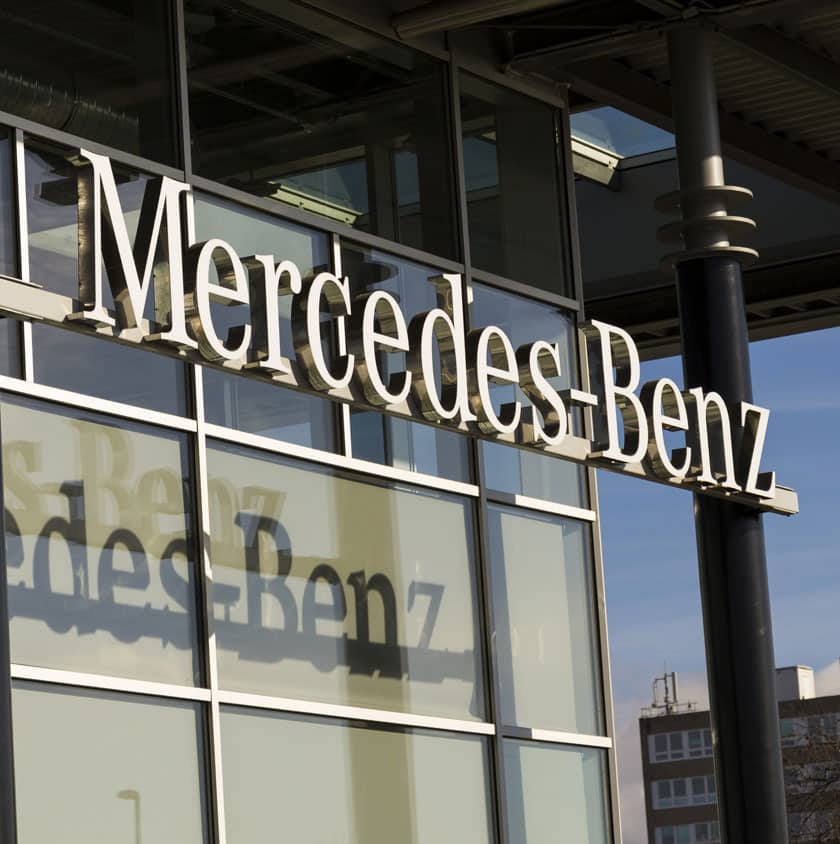
Mercedes-Benz Insurance
Compare Mercedes-Benz Car Insurance Quotes
- Compare 120+ insurers
- You could save up to £515*
- Find a great deal today

Compare affordable Mercedes-Benz car insurance from top UK’s leading car insurers including:
Why Compare Mercedes-Benz Car Insurance Quotes at SimplyQuote?
Mercedes-Benz insurance premiums can vary wildly depending on the model, trim, performance spec, and even ownership type—so comparing quotes isn’t just smart, it’s essential.
A base A-Class hatchback doesn’t carry the same insurance profile as a GLC Coupe or a fully electric EQC SUV. Then there’s AMG—where just one letter on the badge can move you up multiple insurance groups. Add in panoramic glass, high-end infotainment, and driver assistance tech, and the price difference between policies can be hundreds of pounds.
That’s why SimplyQuote.co.uk exists: to help you see your real insurance options, side by side, in a few minutes. We’ve partnered with Quotezone to surface tailored quotes from FCA-regulated UK insurers, many of whom understand what it takes to cover a Mercedes properly—whether that’s OEM part guarantees, access to approved repairers, or EV-specific battery protection.
Some policies even cater to lease and PCP drivers by including features like GAP insurance or mandatory repair clauses—things generic cover might miss entirely.
Ultimately, insuring a Mercedes isn’t just about finding the lowest number. It’s about matching the cover to the car. That’s what car insurance comparison does best.
Who Are Mercedes-Benz?
Mercedes-Benz is one of the world’s oldest and most prestigious car manufacturers—known for combining engineering excellence with luxury, technology, and innovation.
Founded in 1926, but tracing its automotive roots back to Karl Benz’s original motor car in 1886, Mercedes-Benz has become synonymous with premium motoring. Today, it operates under the global Stellantis Group and offers everything from entry-level hatchbacks to electric SUVs and fire-breathing AMGs.
In the UK, Mercedes consistently ranks among the top ten most popular brands. Its model range is vast and often badge-led:
- A-Class and B-Class for compact practicality
- C-Class and E-Class for executive saloons
- GLA, GLC, GLE for SUVs
- EQC, EQE, EQS for full-electric luxury
- AMG 35/43/63 models for high-performance trims
This diversity comes with insurance implications. A Mercedes A180d AMG Line may sit in a low-20s insurance group, while a C63 S could be double that—before factoring in customisation or use type.
Mercedes-Benz vehicles are also commonly leased or financed, which raises the importance of policies that include manufacturer-approved repairs, GAP protection, and clauses that align with finance agreements.
Understanding the Mercedes ecosystem helps explain why insurance isn’t one-size-fits-all. The badge might be familiar—but the car behind it can be anything from a budget-conscious saloon to a 500bhp, tech-laden rocket.

What Do I Need To Get A Quote?
To get a Mercedes-Benz insurance quote, you’ll need your vehicle details, how you use it, where it’s kept, and some basic driver history. It takes less than five minutes—and there’s no paperwork required upfront.
Because Mercedes-Benz models vary widely in trim, performance, and tech, it’s important to be accurate when selecting your vehicle. An A-Class Sport and an AMG Line Premium Plus may look similar on paper, but the insurance risk (and cost) can be very different.
Here’s what you’ll be asked to provide:
- Vehicle details – You can enter your reg number or manually select your model and trim (e.g. C-Class AMG Line, GLC 220d, EQB 300). Hybrid and electric models will also ask about battery or range specs.
- Usage classification – Whether the car is for social use, commuting, or business. If you’re using your leased GLE for client meetings, that matters.
- Where it’s kept overnight – Garage, driveway, or on-street parking—especially relevant for higher-value and keyless-entry models.
- Estimated annual mileage – Helps insurers assess wear, risk exposure, and EV battery stress (where applicable).
- Any modifications – Even Mercedes OEM packs (e.g. Night Package, black alloys, Burmester upgrades) should be disclosed if not part of the factory standard for that trim.
- Driver information – Age, licence type, no-claims bonus, convictions, and any recent claims.
Once submitted, your quotes are generated instantly. If your details are accurate, what you see is what you’ll pay—no surprises when you click through.
Why Should I Consider Mercedes-Benz-Specific Car Insurance Cover?
Because Mercedes vehicles carry specialist features—from keyless tech to AMG performance—and not every policy is built to cover that complexity.
A standard insurance policy might be fine for a city hatchback—but a Mercedes isn’t just another car. Whether you’re driving an entry-level A-Class or a high-performance AMG C63, your policy needs to reflect how the car’s built, repaired, and used.
Consider this:
- Trim-specific risk matters – A C-Class AMG Line Premium Plus has more tech, larger wheels, and different safety features than a basic SE. Insurers who recognise that are more likely to price fairly—and cover accordingly.
- Manufacturer-approved repairs – For leased or financed vehicles, this is often a requirement. A policy without it can void your finance terms or reduce resale value.
- Keyless entry and theft risk – Mercedes models with keyless-go systems are more vulnerable to relay attacks. Not every insurer includes enhanced theft cover as standard.
- Electric and hybrid components – With models like the EQB and EQE on UK roads, cover for battery packs, cables, and repair networks becomes essential—especially given the cost of parts and availability of qualified technicians.
- Performance models need tailored terms – An AMG GLA 45 or E63 S has unique repair and risk profiles. A generic policy might class it the same as a standard diesel—until you try to make a claim.
In short: if you’re paying for a Mercedes, make sure your insurance policy knows it. A few extra minutes to compare cover options designed with the brand in mind can save you time, money, and disputes later.

What Does Mercedes-Benz Car Insurance Cover Include?
A comprehensive Mercedes-Benz insurance policy usually includes liability, theft, fire, and accidental damage—alongside options like OEM parts, key cover, and EV-specific protection.
At its core, a comprehensive policy covers you against third-party damage, your own vehicle’s damage in an accident (even if you’re at fault), and non-collision events like theft or fire. But with a Mercedes, especially newer or high-spec models, there’s more to consider.
Here’s what’s commonly included—and why it matters:
- Third-party liability – Covers injury or property damage you cause to others.
- Fire and theft – Applies whether your AMG GLC is stolen from a driveway or damaged by an engine fire.
- Accidental damage – Pays to repair your Mercedes if involved in a crash or if someone hits it while parked.
- Windscreen and glass cover – Especially important for models with driver-assist sensors or panoramic glass.
- Courtesy car – Typically provided if your Mercedes is being repaired by an approved garage.
- Personal belongings cover – Some policies include protection for items inside your car—handy for execs using E-Class saloons for business.
- Audio and infotainment cover – Mercedes’ MBUX systems aren’t cheap. Most policies protect factory-fitted tech, but not always aftermarket upgrades.
- Key cover – Crucial for keyless-go models, which are increasingly common across the range.
- EV-specific features – On EQ models (EQB, EQC, EQE), some insurers include battery and charging cable cover as standard or optional extras.
Some providers also offer Mercedes-Benz-approved repair networks as standard—an important inclusion for leased vehicles where repair quality impacts residual value.
Coverage varies by provider, so it’s always worth checking what’s standard, what’s optional, and what’s missing.
What’s Not Included?
Even comprehensive Mercedes-Benz insurance has exclusions—particularly around modifications, incorrect use, general wear, and undeclared factory options.
Mercedes owners often assume that a top-tier policy covers everything by default. But the more sophisticated the car, the more critical the fine print becomes—especially if you drive an AMG, a plug-in hybrid, or a leased vehicle.
Here are common exclusions to watch for:
- Undeclared modifications – If you’ve added a performance pack, changed the wheels, or wrapped your GLA AMG Line, failing to disclose it could invalidate your cover.
- Track or performance use – Unless you’ve taken out specialist track-day insurance, your policy won’t cover circuit driving—even for AMG models built for speed.
- Wear and tear – Items like brake pads, tyres, and hybrid battery degradation are classed as maintenance, not insurable risks.
- Incorrect use classification – Using your E-Class saloon for client visits under a social-use policy could void a claim.
- Unapproved repairs – If your finance agreement specifies Mercedes-Benz-approved repairers and you use a non-affiliated garage, that could breach both the policy and your lease terms.
- Negligence-related theft – Leaving your keyless-go system vulnerable (e.g., in a coat pocket near the front door) and having the car stolen could lead to claim refusal—especially if no anti-theft measures were in place.
Some of these may sound harsh—but insurers assess risk on the basis of strict declarations and usage assumptions. The more accurate and complete your disclosures, the less likely you are to be caught out later.
How Much Does Mercedes-Benz Car Insurance Cost?
Mercedes-Benz insurance costs typically range from £850 to over £2,500 per year in the UK—depending on your model, trim, age, postcode, usage, and driving history.
Mercedes drivers aren’t paying for a logo—they’re insuring everything behind it: complex engineering, premium materials, and high-spec tech. That means the price of cover can vary drastically. A diesel A-Class in a rural postcode will sit at one end of the scale, while a leased AMG C63 S in London will be on a different planet altogether.
Let’s look at some estimated annual insurance ranges:
| Mercedes-Benz Model | Category | Typical Insurance Cost (Annual) |
|---|---|---|
| A180 SE (A-Class) | Entry-level hatchback | £850–£1,100 |
| GLA 200 AMG Line | Compact SUV | £1,000–£1,400 |
| C-Class AMG Line Saloon | Executive saloon | £1,100–£1,600 |
| GLC 220d 4MATIC | Mid-size SUV | £1,200–£1,700 |
| EQB 300 4MATIC | Electric SUV | £1,200–£1,800 |
| E-Class Estate | Large executive estate | £1,300–£1,900 |
| AMG A35 4MATIC | Performance hatchback | £1,500–£2,200+ |
| AMG GLE 63 S | Performance SUV | £2,000–£2,800+ |
But it’s not just about the car. These five factors will significantly shape your premium:
- Driver age and history – New drivers, recent claims, or points will raise costs—especially with AMG or EQ models.
- Location and parking – Urban areas with theft risk (particularly for keyless models) drive premiums up.
- Cover type – Fully comp with extras like battery cover or GAP costs more than basic third-party fire and theft.
- Finance status – Leasing? Insurers often expect manufacturer-approved repairs and higher cover levels.
- Mileage and usage – Business use or high annual mileage affects exposure—and insurers price accordingly.
The key takeaway? With Mercedes, the gap between policies isn’t just about price—it’s about what’s actually covered, what’s excluded, and how well the insurer understands your car.
How To Compare Mercedes-Benz Car Insurance At SimplyQuote.co.uk
Getting Mercedes-Benz insurance quotes through SimplyQuote.co.uk takes just a few minutes—and helps you find cover that fits your car, your usage, and your expectations.
Whether you’re driving an EQB on a lease or own a C-Class AMG Line outright, your cover needs to reflect more than just the badge.
Here’s how the process works:
- Step 1: Enter your car details
Start by entering your vehicle registration. If you don’t have it handy, you can search by model, fuel type, and trim (e.g. GLC 220d 4MATIC, EQE 300, AMG GLA 35). - Step 2: Tell us how you use it
Is your Mercedes used just for social driving, or do you commute or visit clients? Accurate usage classification ensures you’re properly covered—and that you’re not overpaying. - Step 3: Specify where it’s kept and who drives it
Insurers need to know your parking situation (garage, drive, street), any named drivers, and your recent driving history. This is where things like no-claims bonus or endorsements come into play. - Step 4: Choose your level of cover and extras
From third-party to comprehensive, you’ll be able to add extras like key cover, legal expenses, EV protection, and more. You’ll also see if OEM repair networks are included—especially useful for finance and warranty compliance. - Step 5: Compare and buy
You’ll get real-time quotes from FCA-regulated insurers. Many policies can be purchased online immediately with documents sent straight to your inbox.
The entire process is designed to give you transparency—so you can see exactly what you’re getting, whether that’s battery cover for your EQC or AMG-specific parts replacement.
*51% of consumers could save £515.24 on their Car Insurance. The saving was calculated by comparing the cheapest price found with the average of the next six cheapest prices quoted by insurance providers on Seopa Ltd’s insurance comparison website. This is based on representative cost savings from December 2024 data. The savings you could achieve are dependent on your individual circumstances and how you selected your current insurance supplier.
Frequently Asked Questions
Yes, on average. Mercedes vehicles tend to fall into higher insurance groups due to their performance, repair costs, and onboard tech—especially AMG and electric models.
The A-Class A180 SE or Sport is typically the cheapest to insure. It’s lower in value, less powerful than AMG trims, and falls into more favourable insurance groups.
It helps. Leased Mercedes cars often require manufacturer-approved repairs, which not all insurers offer. Some finance providers also expect certain levels of excess and policy conditions.
Yes. Vehicles with keyless entry are more prone to relay theft. Some insurers may charge more unless additional anti-theft measures (like signal blockers) are used.
They can be. Mercedes EQ models (like EQB, EQC, EQE) involve higher repair costs and fewer approved repairers. Battery cover and EV-specific features may also affect pricing.
Yes. Temporary car insurance is available for Mercedes drivers needing short-term cover—ideal for borrowing, test drives, or day trips. It’s flexible, but often more expensive per day than annual policies.
Typically, yes. AMG models have higher performance, pricier parts, and more expensive repair processes—especially for models like the GLE 63 or C63 S.
Not by default. Some comprehensive policies offer breakdown as an optional extra. Always check whether it’s included and whether the provider offers roadside and home start cover.










